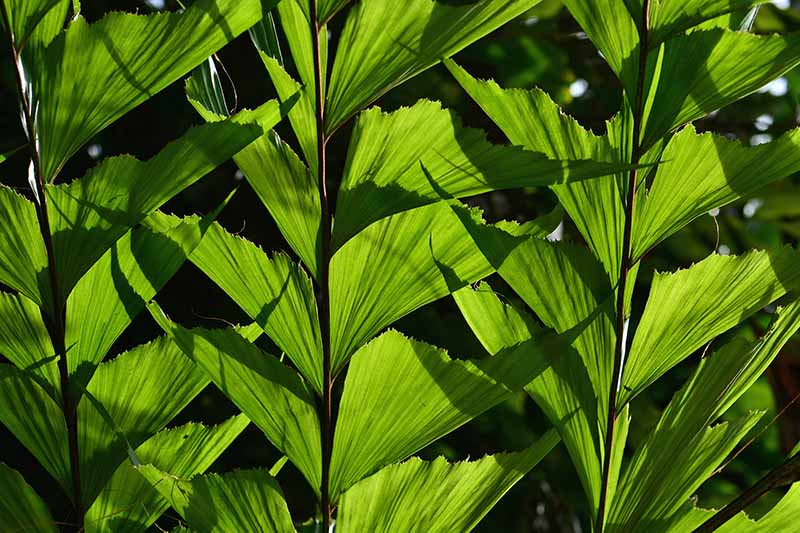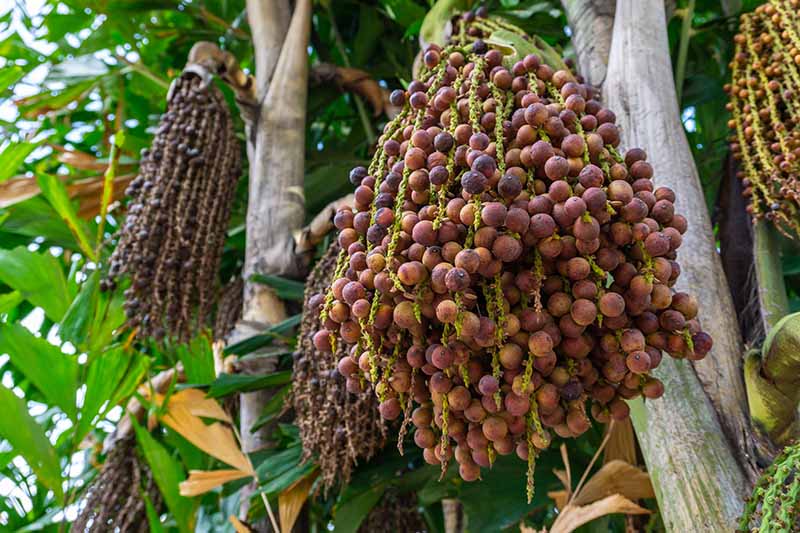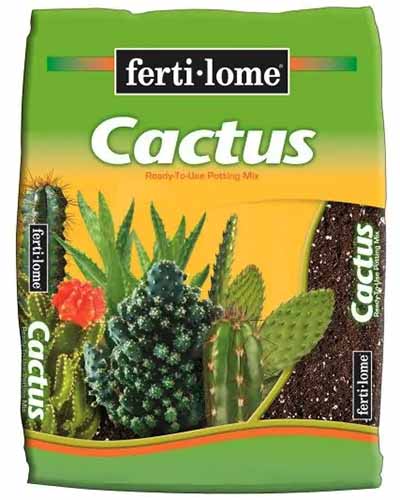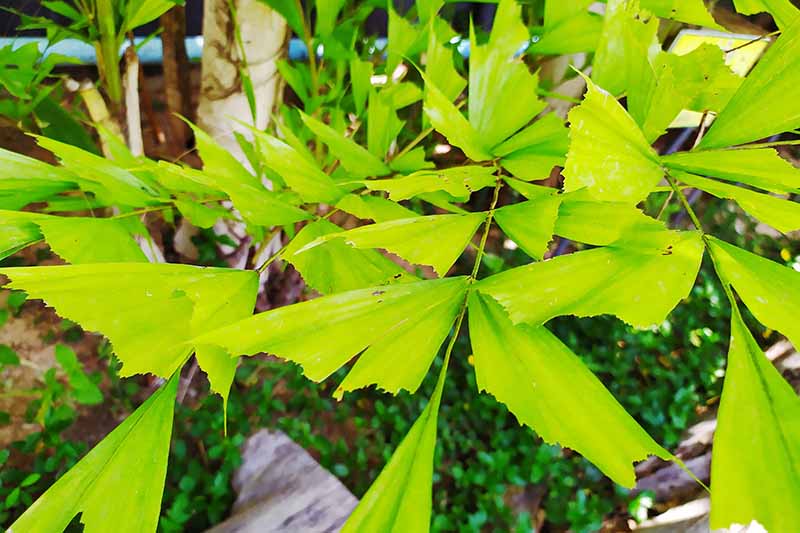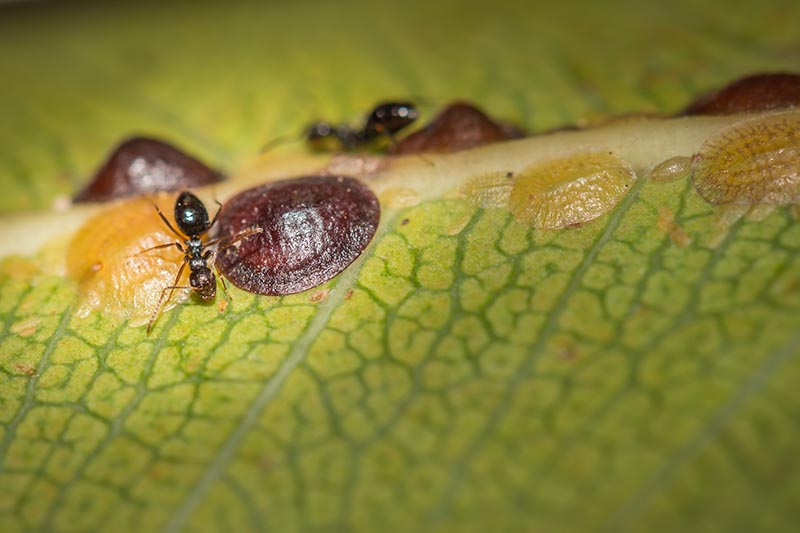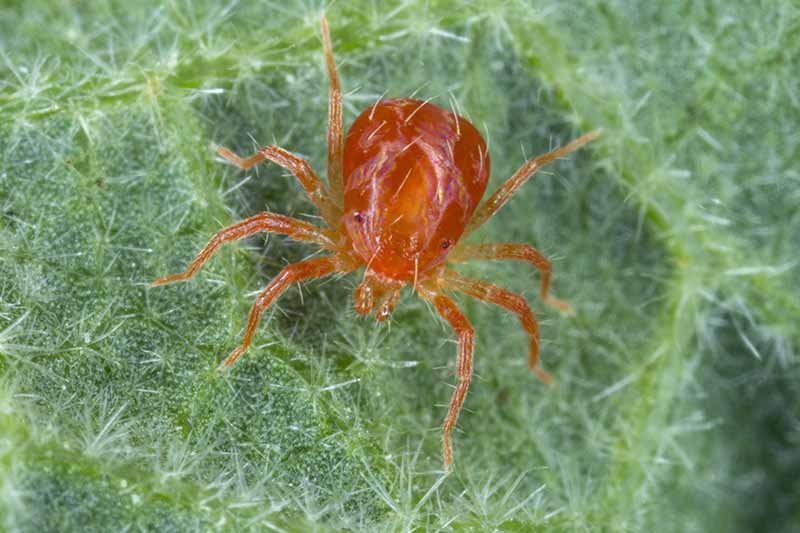But before you rush out and buy one, I’m going to level with you. These palms aren’t that easy to grow indoors. They do much better in outdoor environments, in USDA Hardiness Zones 8 to 11. That’s not to say that you can’t succeed at growing a gorgeous specimen, but it’s going to take some diligence on your part. But isn’t part of the fun of houseplant parenting the challenge of it? We link to vendors to help you find relevant products. If you buy from one of our links, we may earn a commission. You can do it. To help you achieve success, here’s what you can expect up ahead: If you want the breezy feel of a tropical vacation, but you don’t feel up to the challenge of caring for a fishtail palm, you might want to consider an areca or a lady palm instead. But if you’re ready for the task ahead, fishtail palms are worth the work. Ready to learn more? Let’s begin!
What Is a Fishtail Palm?
Fishtail palms belong to the genus Caryota, which includes over a dozen species. The one that is best adapted and most popular as a houseplant is C. mitis. It’s native to tropical regions across Asia, from India to the Philippines, where it grows in forests and disturbed areas. And it has been naturalized in tropical areas across the world, including parts of North America, Latin America, and Africa. It has even become invasive in Australia, Florida, and Hawaii. The botanical name Caryota is Greek for nut (a reference to the fruit), and mitis is Latin for unarmed, which describes the fact that these palms don’t have spines as some other similar-looking palms do. They’re also sometimes called clustering or clumping fishtails, or Burmese palms. Note that all plants in this genus are called fishtail palms because of the distinctive leaves, but when we talk about growing fishtail palms as houseplants, it’s the mitis species that we’re referring to. You might rarely come across C. urens (solitary fishtail palm) for sale as an indoor plant outside of the US. C. gigas, C. mitis, C. monostachya, C. obtusa, C. rumphiana, and C. urens are sold as outdoor specimens in tropical areas. Outdoors, C. mitis can reach up to 40 feet tall, but they stay much, much smaller inside. Usually, they won’t reach a height of more than six feet, but they can grow up to 10 feet tall if you have high ceilings and the appropriate amount of light exposure. Indoors, these plants are made up of multiple stems, which grow via suckering. When grown outdoors, mature plants are made up of one main trunk rather than a cluster of stems, and they send out suckers to reproduce. Not all Caryota species are suckering. All plants in this genus are monocarpic, which means the main trunk dies after the plant flowers and fruits. The leaflets have a triangular shape and meet in the middle. The term for leaves like this that look like two conjoined triangles is bipinnate, and plants in the Caryota genus are the only palms with this type of leaf. The leaves are somewhat waxy with a wavy, ragged edge. These plants may produce purple or red flowers and red fruits when grown outdoors, but they rarely flower indoors. By the way, don’t eat the fruits (or even handle them) if you come across them, even though the kernel inside each one is technically edible. They’re filled with shards of crystals called raphides which are made up of calcium oxalate and, as you can probably imagine, ingesting these crystals is extremely irritating. They’re not chemically poisonous, but rather, cause physical damage to the throat and mouth. That doesn’t stop animals like civets, boars, and birds from eating them, though. These crystals exist in all parts of the plant, so wear gloves if you ever need to handle yours.
Cultivation and History
C. mitis is most often cultivated for sale across the world in Ecuador, Fiji, Australia, and China. It was first identified by botanist João de Loureiro, who spotted the palm in Vietnam and described it in 1790, just one year before his death. Since then, it has spread across the globe primarily as an outdoor specimen in warm regions, but it is also an option for those who want to bring a tropical vibe into their homes.
Propagation
There are only two ways to propagate a fishtail palm: from seed, or from divisions. You can always purchase a seedling or young tree as well, and this is the most common method for people to obtain one.
From Seed
Though you’d be hard-pressed to find seeds at a local shop if you don’t reside in a tropical area, they are sometimes available online. To plant the seeds, fill a four-inch container with a mixture of one part seed-starting medium combined with one part sphagnum moss. Plant two seeds an inch deep in each container. Water the medium well and tent a plastic bag over the container. Use a chopstick to keep the plastic away from the soil. Place in an area with bright, indirect light. Every day, open the plastic and check the moisture level. Add more water to keep the medium feeling like a well wrung-out sponge. If both of the seeds germinate, pluck the weaker of the two. Seeds take about three weeks to germinate. Once the seedling is about six inches tall, you can transplant it into a permanent container. Leave the plastic bag off for a week or two before transplanting to allow the palm to acclimate to a drier environment.
From Divisions
These plants are incredibly easy to divide if you have access to a specimen with at least four stems. To do so, remove the existing plant from the container and brush away as much of the soil as possible. Then, find a natural division between stems and gently pull the two sides apart. The roots will likely be all tangled up, but just do your best to tease them apart. If you need to, use some secateurs to cut apart stubborn knots. Now, place each section in its own container and fill in around it with potting medium. The plant should be sitting at the same height that it was before. Water well, wait 30 minutes, and then be sure to empty the drip tray or saucer so your plant isn’t sitting in standing water.
From Seedlings/Transplanting
Most people opt to purchase a seedling or a young transplant. You can even find older plants that are upwards of six feet tall if you’re impatient for a dramatic display (raises hand). If your plant came in a decorative pot with good drainage, don’t worry about repotting for a few years. If you purchased a small specimen in a nursery pot, you can transplant it when you bring it home. These plants don’t have an extensive root system, and most of the roots grow near the surface of the soil. You don’t need a particularly deep pot, but pick one that is a few inches wider than the clump of stems to provide about two inches around the perimeter. Don’t be tempted to pick a container that is much larger than that. These plants prefer to be a bit rootbound and it’s difficult to give them the water they crave if you plant them in a container that is too large. Make absolutely sure that your chosen container provides good drainage. Fishtail palms won’t survive if their roots are too wet. I know some of those pretty decorative cachepots without drainage holes are tempting, but they’re a death sentence for your fishtail palm. Perhaps the biggest challenge with growing fishtail palms is providing enough light. They need lots of extremely bright light, but they don’t do well with direct afternoon sunlight. Loosen the soil and root ball. Fill the base of your chosen container with potting soil, preferably one that’s formulated for palms or cacti. Fertilome Cactus Potting Soil Mix Fertilome makes a cactus potting soil mix that I like to use. It’s available in four-quart bags from Nature Hills Nursery.
How to Grow
Some early morning light is fine, and then they need as much bright, indirect light as they can get throughout the rest of the day. That means your plant will probably do best if it’s situated near an east-facing window. They also like to be toasty warm. Temperatures should be right around 65 to 85°F, so if you like to keep your home cool, this might not be the right addition for your indoor garden. Ideally, there will also be a fluctuation of at least 10 degrees from day to night, and temps should never drop below 55°F. Being tropical plants, you might have guessed that they like water, and you’d be right. They don’t like to dry out too much and they prefer lots of humidity. Water as soon as the top inch of soil has dried out. If you planted in a palm or cactus potting mix, this could mean watering every few days during warm weather. To test the soil moisture, just stick your finger into the soil. It should feel like a well wrung-out sponge. If it feels dry to your first knuckle, add water. Empty the catchment saucer or container after 30 minutes or so, to ensure that the plant isn’t sitting in excess water that’s drained out. If the edges of the leaves begin to turn brown, it’s likely too dry for your palm. And to be perfectly honest, most homes are too dry. Buy a humidifier or mist your plants once or twice a day. Too little moisture in the soil can also cause the edges of the leaves to turn brown. It can be hard to know for sure what’s causing it, so you might consider investing in a soil moisture meter to help make the process of watering easier. Some moisture meters are multi-purpose so you can test humidity and light, as well. On the other hand, if the leaves are turning yellow or brown overall, and not just on the ends, it’s likely due to too much water, not enough light, or both, resulting in rotting roots. Mushy brown spots are another sign of trouble at the root level. Fishtail palms aren’t prone to root rot disease that’s caused by an infectious pathogen, but they are easily drowned in soil that contains too much water. Reduce the amount of water you’re providing and allow the top two inches of soil to dry out before watering again. Move the plant into a slightly brighter spot as well. Dust or wipe the leaves with a damp cloth every month or so to remove dust and to discourage spider mites, which we’ll dive into in greater detail in just a minute.
Growing Tips
Keep in bright, indirect sunlight.Water when the top inch of soil dries out.Don’t allow temperatures to dip below 55°F.
Pruning and Maintenance
Despite being a tree, there is no need to prune your fishtail palm. Unless a branch dies or is heavily infested with spider mites or scale, just let it do its thing. If you want to limit its growth, you can pinch off the growing tip. This will prevent any further growth from developing along the length of the stem. If you prefer an overall shape with a single stem or just a few stems, you can certainly remove any young suckers, but your houseplant won’t ever develop a big, single, bulky trunk as it can outdoors. Leave the suckers in place for a fuller look. For the first decade or so, you’ll need to increase the size of the container every few years. When you replant your fishtail palm in its new container, choose one that is just one size larger. Remember, this plant needs a relatively small container and prefers to be a bit rootbound. It doesn’t do well if you place it in a large pot where it may easily be overwatered. To repot, gently remove the plant from its container and knock as much of the soil away as you can from the root ball. Gently tease apart the roots to loosen them up, and trim away any dead or mushy roots that you come across. Place a layer of soil in the bottom of the new container so the plant will sit at the same height as it was previously. Place the plant in the new container and fill in around the roots with fresh potting soil. After it has reached six to ten feet in height, you don’t need to upgrade the pot size any longer, but you should still remove it from its pot and refresh the soil every few years. Potting soil becomes compacted and loses nutrients over time, and it can also become hydrophobic. Replacing the soil helps to prevent these issues.
Insects
Beyond the occasional spider or errant wasp, there are rarely enough predators around to keep the insects that like to feed on houseplants under control. Fishtail Palm If you want to add one of these beauties to your houseplant collection, you can pick up two- to three- as well as three- to four-foot-tall plants from Fast Growing Trees.
Managing Pests and Disease
You don’t need to worry about diseases with your indoor plant. Though root rot can be a common occurrence if fishtail palms aren’t cared for properly, this isn’t often caused by any type of pathogen. But you do need to watch for pests. Fishtail palms are exceptionally susceptible to spider mite infestations. That’s why it’s common to see spider mites, scale, and certain other pests on your houseplants. While fishtail palms maintain the unique status of being blessedly aphid-free, they’re susceptible to mites and scale.
Scale
If you grow houseplants for long enough, the chances are pretty good that you’ll come across soft scale at some point. These insects from the Hemiptera family are flat, round little pests that feed by using their sucking mouthparts to extract the sap from the leaves and stems of plants. It’s easy to mistake these pests for a sign of disease because they look sort of like little brown or gray lumps, and they’re usually found on the stems and trunks. They aren’t very active, either, which adds to the illusion. Beyond looking for the pests themselves, you might notice leaves turning yellow and, in extreme cases, stunted growth or entire stems dying back. Control usually involves a multi-pronged approach. The first step is to prune away any heavily infested areas if you can do so without damaging the plant overall. Another alternative is to scrape away the scale with a butter knife. In addition to or instead of these mechanical control methods, you can wipe each insect with isopropyl alcohol, which takes away their protective coating and leaves them vulnerable to the elements. Finally, you might need to resort to neem oil or insecticidal soap. Our guide to identifying and controlling scale has more details.
Spider Mites
I’ll tell you right now, you’re going to need to prepare yourself to deal with spider mites. These little pests are extremely common on houseplants, and especially so on fishtail palms. It’s a good thing spider mites are fairly easy to deal with, because the chances are pretty high that you’ll need to address an infestation at some point. Don’t wait for an infestation to grow large before tackling it. Instead, check your plant once a week for webbing. If you see any fine webs on the plant, look closely for itty-bitty spider-like critters. They especially love to hang out where the leaves meet the stem. You may or may not see them running around, but if the webbing is present, it’s safe to assume they are there. Other signs of their presence include palm leaves that turn yellow or that have yellow spotting, and a general loss of vigor. The most common species found on houseplants is the red spider mite (Tetranychus urticae) but others may infest your plant as well. Because these invertebrates prefer dry conditions, keeping your plant watered well and increasing humidity is a good first line of defense. Next, take your plant into the shower (if you can lift it) and give it a nice rinse to wash away as many of the mites as you can. You might have to do this repeatedly to make a dent in combating the infestation. Finally, break out the insecticidal soap or neem oil and apply it once a week until they’re gone. Don’t bother with insecticides. Spider mites easily develop resistance. For more tips, read our comprehensive guide.
Best Uses
Fishtail palms are primarily used as single-specimen displays in the home, but you have a few options as to what kind of shape you choose to give your plant. You can let the suckers grow naturally for a bushy appearance, or you can remove the suckers and encourage a single trunk with a canopy of leaves to form. But in my humble opinion, they’re worth the extra effort. The foliage is incredibly unique, and a full-grown specimen is quite a thing to see. Given the right levels of light exposure and moisture, and so long as you keep a close eye out for spider mites, you can succeed at growing these dramatic palms. Is this your first palm, or do you have a lot of experience with these plants? What other species have you tried growing and how is your fishtail palm doing? Let us know in the comments. Hopefully you found that this guide set you on the path to success. Looking to expand your palm jungle even more? Read these houseplant guides next:
How to Grow Ponytail Palm IndoorsHow to Grow and Shape Ponytail Palms as BonsaiHow to Grow Parlor Palms Indoors


